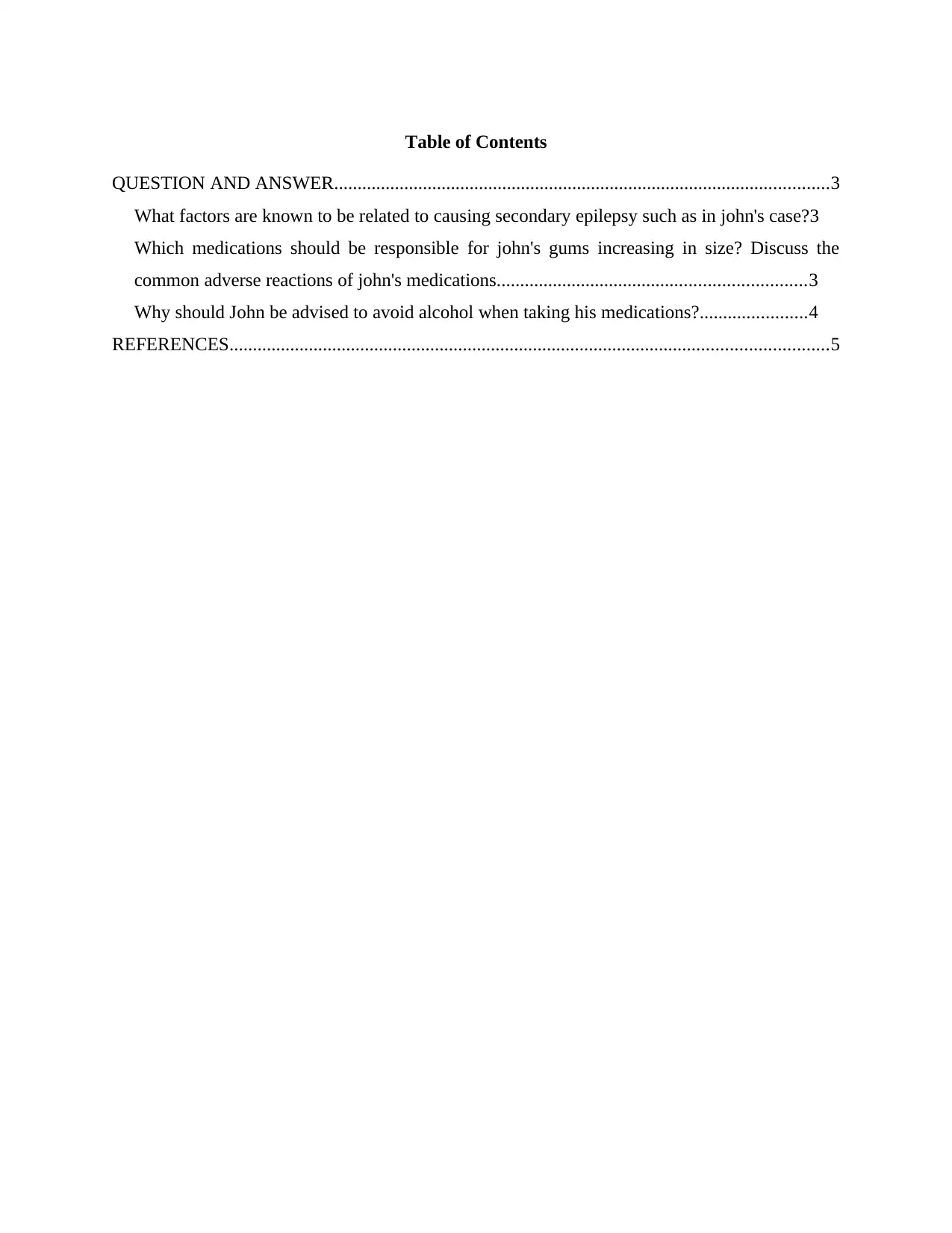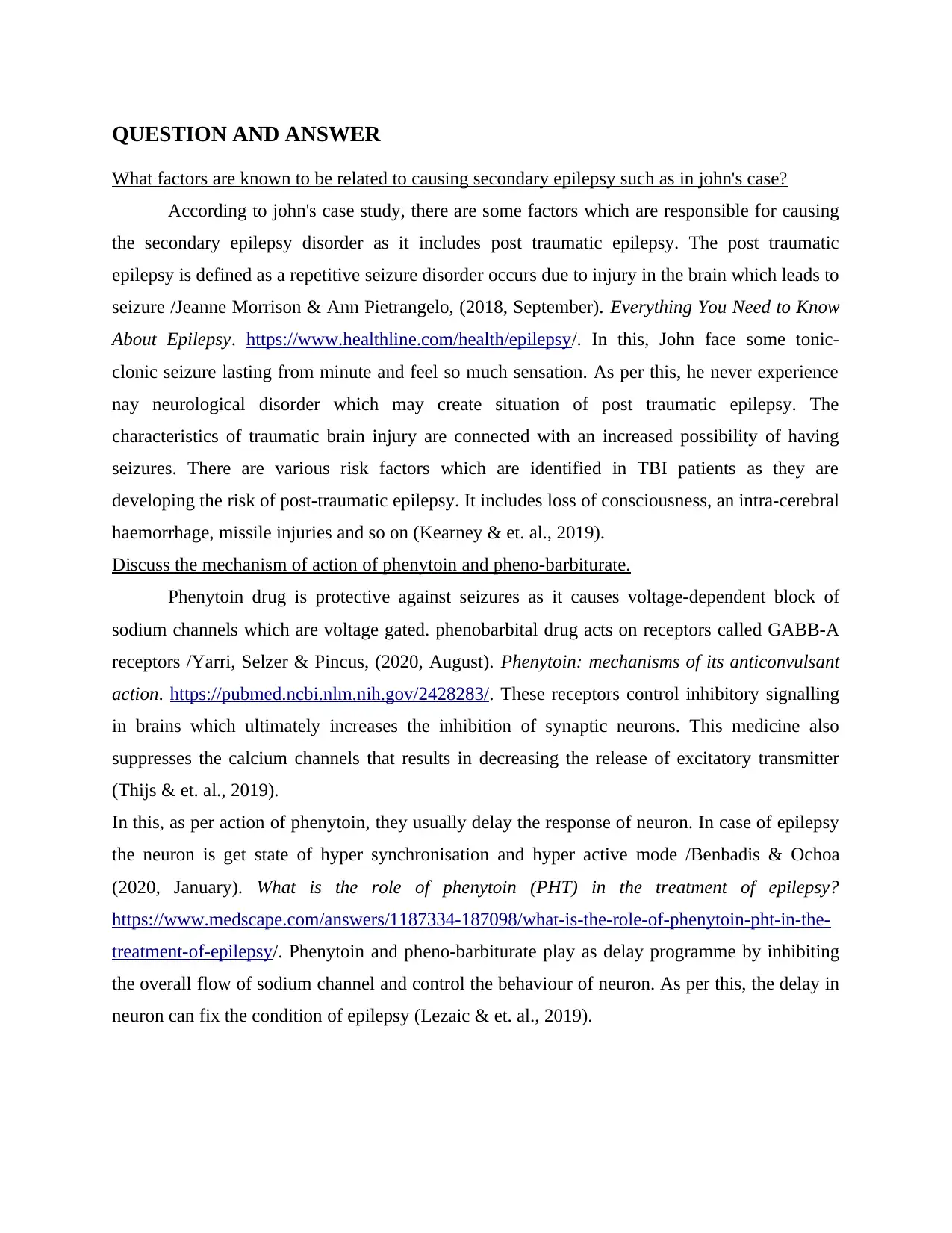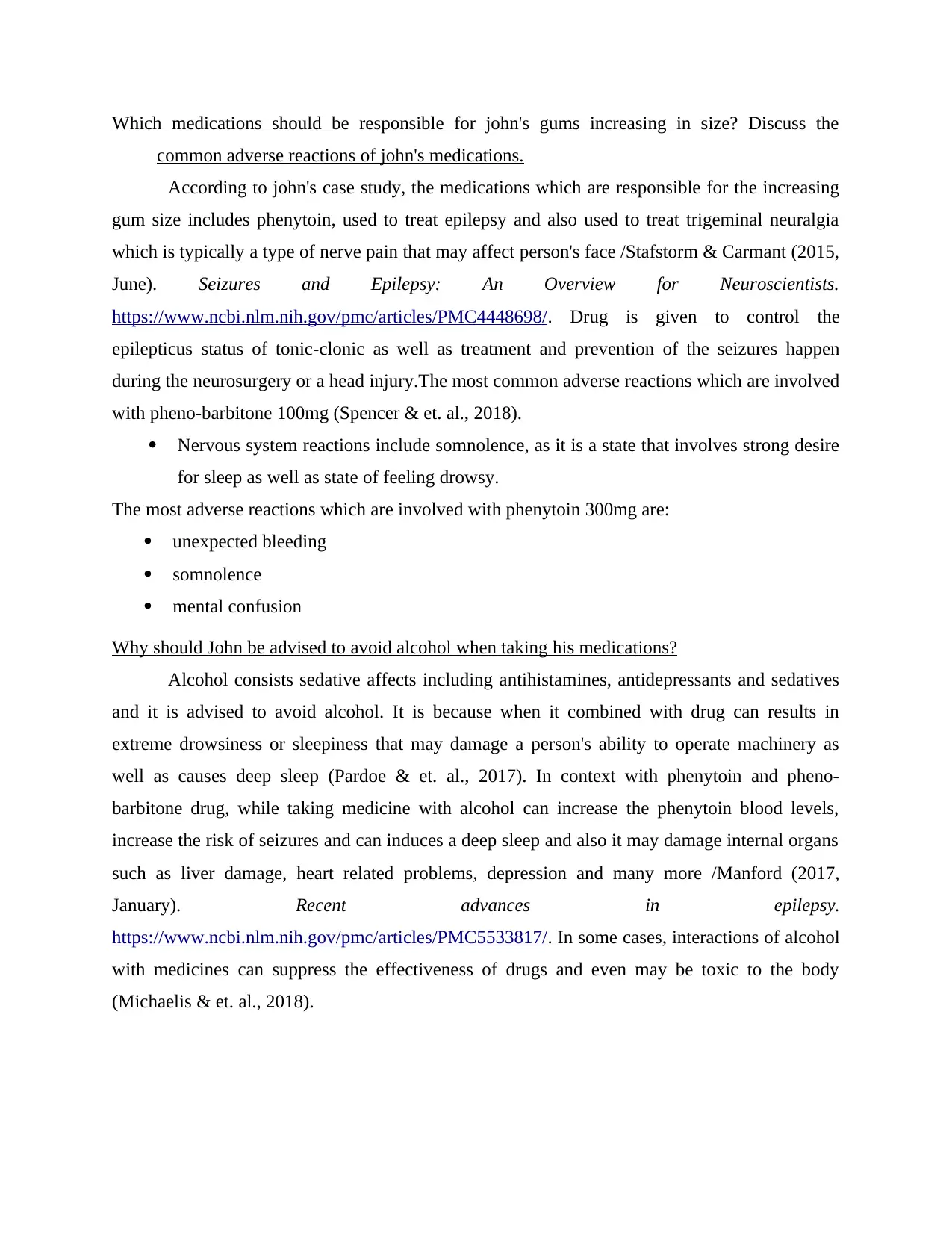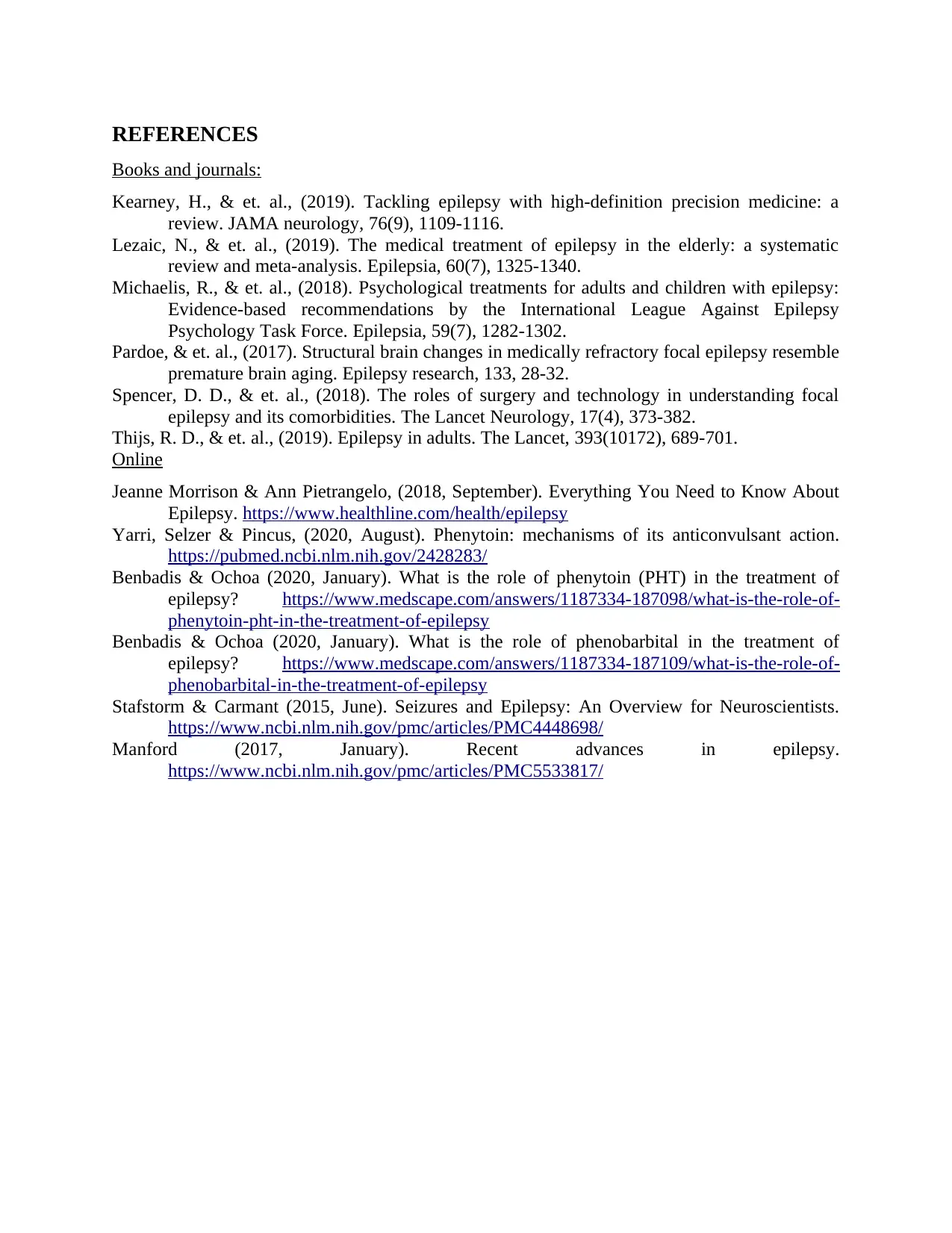Case Study: Secondary Epilepsy, Medication Side Effects, and Alcohol
VerifiedAdded on 2023/06/18
|6
|1178
|423
Case Study
AI Summary
This case study delves into John's case of secondary epilepsy, specifically post-traumatic epilepsy resulting from a brain injury. It identifies factors contributing to this condition, such as loss of consciousness and intra-cerebral hemorrhage. The study discusses the mechanisms of action of phenytoin and phenobarbital, two anticonvulsant medications used in treatment, explaining how they inhibit neuronal activity to prevent seizures. It also highlights phenytoin as the medication likely responsible for John's increased gum size and outlines common adverse reactions associated with both drugs, including somnolence and unexpected bleeding. Furthermore, the case study emphasizes the importance of advising John to avoid alcohol due to its sedative effects and potential interactions with his medications, which can lead to increased risk of seizures, deep sleep, and organ damage. The analysis is supported by references to relevant books, journals, and online resources.

CASE STUDY
Paraphrase This Document
Need a fresh take? Get an instant paraphrase of this document with our AI Paraphraser

Table of Contents
QUESTION AND ANSWER..........................................................................................................3
What factors are known to be related to causing secondary epilepsy such as in john's case?3
Which medications should be responsible for john's gums increasing in size? Discuss the
common adverse reactions of john's medications..................................................................3
Why should John be advised to avoid alcohol when taking his medications?.......................4
REFERENCES................................................................................................................................5
QUESTION AND ANSWER..........................................................................................................3
What factors are known to be related to causing secondary epilepsy such as in john's case?3
Which medications should be responsible for john's gums increasing in size? Discuss the
common adverse reactions of john's medications..................................................................3
Why should John be advised to avoid alcohol when taking his medications?.......................4
REFERENCES................................................................................................................................5

QUESTION AND ANSWER
What factors are known to be related to causing secondary epilepsy such as in john's case?
According to john's case study, there are some factors which are responsible for causing
the secondary epilepsy disorder as it includes post traumatic epilepsy. The post traumatic
epilepsy is defined as a repetitive seizure disorder occurs due to injury in the brain which leads to
seizure /Jeanne Morrison & Ann Pietrangelo, (2018, September). Everything You Need to Know
About Epilepsy. https://www.healthline.com/health/epilepsy/. In this, John face some tonic-
clonic seizure lasting from minute and feel so much sensation. As per this, he never experience
nay neurological disorder which may create situation of post traumatic epilepsy. The
characteristics of traumatic brain injury are connected with an increased possibility of having
seizures. There are various risk factors which are identified in TBI patients as they are
developing the risk of post-traumatic epilepsy. It includes loss of consciousness, an intra-cerebral
haemorrhage, missile injuries and so on (Kearney & et. al., 2019).
Discuss the mechanism of action of phenytoin and pheno-barbiturate.
Phenytoin drug is protective against seizures as it causes voltage-dependent block of
sodium channels which are voltage gated. phenobarbital drug acts on receptors called GABB-A
receptors /Yarri, Selzer & Pincus, (2020, August). Phenytoin: mechanisms of its anticonvulsant
action. https://pubmed.ncbi.nlm.nih.gov/2428283/. These receptors control inhibitory signalling
in brains which ultimately increases the inhibition of synaptic neurons. This medicine also
suppresses the calcium channels that results in decreasing the release of excitatory transmitter
(Thijs & et. al., 2019).
In this, as per action of phenytoin, they usually delay the response of neuron. In case of epilepsy
the neuron is get state of hyper synchronisation and hyper active mode /Benbadis & Ochoa
(2020, January). What is the role of phenytoin (PHT) in the treatment of epilepsy?
https://www.medscape.com/answers/1187334-187098/what-is-the-role-of-phenytoin-pht-in-the-
treatment-of-epilepsy/. Phenytoin and pheno-barbiturate play as delay programme by inhibiting
the overall flow of sodium channel and control the behaviour of neuron. As per this, the delay in
neuron can fix the condition of epilepsy (Lezaic & et. al., 2019).
What factors are known to be related to causing secondary epilepsy such as in john's case?
According to john's case study, there are some factors which are responsible for causing
the secondary epilepsy disorder as it includes post traumatic epilepsy. The post traumatic
epilepsy is defined as a repetitive seizure disorder occurs due to injury in the brain which leads to
seizure /Jeanne Morrison & Ann Pietrangelo, (2018, September). Everything You Need to Know
About Epilepsy. https://www.healthline.com/health/epilepsy/. In this, John face some tonic-
clonic seizure lasting from minute and feel so much sensation. As per this, he never experience
nay neurological disorder which may create situation of post traumatic epilepsy. The
characteristics of traumatic brain injury are connected with an increased possibility of having
seizures. There are various risk factors which are identified in TBI patients as they are
developing the risk of post-traumatic epilepsy. It includes loss of consciousness, an intra-cerebral
haemorrhage, missile injuries and so on (Kearney & et. al., 2019).
Discuss the mechanism of action of phenytoin and pheno-barbiturate.
Phenytoin drug is protective against seizures as it causes voltage-dependent block of
sodium channels which are voltage gated. phenobarbital drug acts on receptors called GABB-A
receptors /Yarri, Selzer & Pincus, (2020, August). Phenytoin: mechanisms of its anticonvulsant
action. https://pubmed.ncbi.nlm.nih.gov/2428283/. These receptors control inhibitory signalling
in brains which ultimately increases the inhibition of synaptic neurons. This medicine also
suppresses the calcium channels that results in decreasing the release of excitatory transmitter
(Thijs & et. al., 2019).
In this, as per action of phenytoin, they usually delay the response of neuron. In case of epilepsy
the neuron is get state of hyper synchronisation and hyper active mode /Benbadis & Ochoa
(2020, January). What is the role of phenytoin (PHT) in the treatment of epilepsy?
https://www.medscape.com/answers/1187334-187098/what-is-the-role-of-phenytoin-pht-in-the-
treatment-of-epilepsy/. Phenytoin and pheno-barbiturate play as delay programme by inhibiting
the overall flow of sodium channel and control the behaviour of neuron. As per this, the delay in
neuron can fix the condition of epilepsy (Lezaic & et. al., 2019).
⊘ This is a preview!⊘
Do you want full access?
Subscribe today to unlock all pages.

Trusted by 1+ million students worldwide

Which medications should be responsible for john's gums increasing in size? Discuss the
common adverse reactions of john's medications.
According to john's case study, the medications which are responsible for the increasing
gum size includes phenytoin, used to treat epilepsy and also used to treat trigeminal neuralgia
which is typically a type of nerve pain that may affect person's face /Stafstorm & Carmant (2015,
June). Seizures and Epilepsy: An Overview for Neuroscientists.
https://www.ncbi.nlm.nih.gov/pmc/articles/PMC4448698/. Drug is given to control the
epilepticus status of tonic-clonic as well as treatment and prevention of the seizures happen
during the neurosurgery or a head injury.The most common adverse reactions which are involved
with pheno-barbitone 100mg (Spencer & et. al., 2018).
Nervous system reactions include somnolence, as it is a state that involves strong desire
for sleep as well as state of feeling drowsy.
The most adverse reactions which are involved with phenytoin 300mg are:
unexpected bleeding
somnolence
mental confusion
Why should John be advised to avoid alcohol when taking his medications?
Alcohol consists sedative affects including antihistamines, antidepressants and sedatives
and it is advised to avoid alcohol. It is because when it combined with drug can results in
extreme drowsiness or sleepiness that may damage a person's ability to operate machinery as
well as causes deep sleep (Pardoe & et. al., 2017). In context with phenytoin and pheno-
barbitone drug, while taking medicine with alcohol can increase the phenytoin blood levels,
increase the risk of seizures and can induces a deep sleep and also it may damage internal organs
such as liver damage, heart related problems, depression and many more /Manford (2017,
January). Recent advances in epilepsy.
https://www.ncbi.nlm.nih.gov/pmc/articles/PMC5533817/. In some cases, interactions of alcohol
with medicines can suppress the effectiveness of drugs and even may be toxic to the body
(Michaelis & et. al., 2018).
common adverse reactions of john's medications.
According to john's case study, the medications which are responsible for the increasing
gum size includes phenytoin, used to treat epilepsy and also used to treat trigeminal neuralgia
which is typically a type of nerve pain that may affect person's face /Stafstorm & Carmant (2015,
June). Seizures and Epilepsy: An Overview for Neuroscientists.
https://www.ncbi.nlm.nih.gov/pmc/articles/PMC4448698/. Drug is given to control the
epilepticus status of tonic-clonic as well as treatment and prevention of the seizures happen
during the neurosurgery or a head injury.The most common adverse reactions which are involved
with pheno-barbitone 100mg (Spencer & et. al., 2018).
Nervous system reactions include somnolence, as it is a state that involves strong desire
for sleep as well as state of feeling drowsy.
The most adverse reactions which are involved with phenytoin 300mg are:
unexpected bleeding
somnolence
mental confusion
Why should John be advised to avoid alcohol when taking his medications?
Alcohol consists sedative affects including antihistamines, antidepressants and sedatives
and it is advised to avoid alcohol. It is because when it combined with drug can results in
extreme drowsiness or sleepiness that may damage a person's ability to operate machinery as
well as causes deep sleep (Pardoe & et. al., 2017). In context with phenytoin and pheno-
barbitone drug, while taking medicine with alcohol can increase the phenytoin blood levels,
increase the risk of seizures and can induces a deep sleep and also it may damage internal organs
such as liver damage, heart related problems, depression and many more /Manford (2017,
January). Recent advances in epilepsy.
https://www.ncbi.nlm.nih.gov/pmc/articles/PMC5533817/. In some cases, interactions of alcohol
with medicines can suppress the effectiveness of drugs and even may be toxic to the body
(Michaelis & et. al., 2018).
Paraphrase This Document
Need a fresh take? Get an instant paraphrase of this document with our AI Paraphraser

REFERENCES
Books and journals:
Kearney, H., & et. al., (2019). Tackling epilepsy with high-definition precision medicine: a
review. JAMA neurology, 76(9), 1109-1116.
Lezaic, N., & et. al., (2019). The medical treatment of epilepsy in the elderly: a systematic
review and meta‐analysis. Epilepsia, 60(7), 1325-1340.
Michaelis, R., & et. al., (2018). Psychological treatments for adults and children with epilepsy:
Evidence‐based recommendations by the International League Against Epilepsy
Psychology Task Force. Epilepsia, 59(7), 1282-1302.
Pardoe, & et. al., (2017). Structural brain changes in medically refractory focal epilepsy resemble
premature brain aging. Epilepsy research, 133, 28-32.
Spencer, D. D., & et. al., (2018). The roles of surgery and technology in understanding focal
epilepsy and its comorbidities. The Lancet Neurology, 17(4), 373-382.
Thijs, R. D., & et. al., (2019). Epilepsy in adults. The Lancet, 393(10172), 689-701.
Online
Jeanne Morrison & Ann Pietrangelo, (2018, September). Everything You Need to Know About
Epilepsy. https://www.healthline.com/health/epilepsy
Yarri, Selzer & Pincus, (2020, August). Phenytoin: mechanisms of its anticonvulsant action.
https://pubmed.ncbi.nlm.nih.gov/2428283/
Benbadis & Ochoa (2020, January). What is the role of phenytoin (PHT) in the treatment of
epilepsy? https://www.medscape.com/answers/1187334-187098/what-is-the-role-of-
phenytoin-pht-in-the-treatment-of-epilepsy
Benbadis & Ochoa (2020, January). What is the role of phenobarbital in the treatment of
epilepsy? https://www.medscape.com/answers/1187334-187109/what-is-the-role-of-
phenobarbital-in-the-treatment-of-epilepsy
Stafstorm & Carmant (2015, June). Seizures and Epilepsy: An Overview for Neuroscientists.
https://www.ncbi.nlm.nih.gov/pmc/articles/PMC4448698/
Manford (2017, January). Recent advances in epilepsy.
https://www.ncbi.nlm.nih.gov/pmc/articles/PMC5533817/
Books and journals:
Kearney, H., & et. al., (2019). Tackling epilepsy with high-definition precision medicine: a
review. JAMA neurology, 76(9), 1109-1116.
Lezaic, N., & et. al., (2019). The medical treatment of epilepsy in the elderly: a systematic
review and meta‐analysis. Epilepsia, 60(7), 1325-1340.
Michaelis, R., & et. al., (2018). Psychological treatments for adults and children with epilepsy:
Evidence‐based recommendations by the International League Against Epilepsy
Psychology Task Force. Epilepsia, 59(7), 1282-1302.
Pardoe, & et. al., (2017). Structural brain changes in medically refractory focal epilepsy resemble
premature brain aging. Epilepsy research, 133, 28-32.
Spencer, D. D., & et. al., (2018). The roles of surgery and technology in understanding focal
epilepsy and its comorbidities. The Lancet Neurology, 17(4), 373-382.
Thijs, R. D., & et. al., (2019). Epilepsy in adults. The Lancet, 393(10172), 689-701.
Online
Jeanne Morrison & Ann Pietrangelo, (2018, September). Everything You Need to Know About
Epilepsy. https://www.healthline.com/health/epilepsy
Yarri, Selzer & Pincus, (2020, August). Phenytoin: mechanisms of its anticonvulsant action.
https://pubmed.ncbi.nlm.nih.gov/2428283/
Benbadis & Ochoa (2020, January). What is the role of phenytoin (PHT) in the treatment of
epilepsy? https://www.medscape.com/answers/1187334-187098/what-is-the-role-of-
phenytoin-pht-in-the-treatment-of-epilepsy
Benbadis & Ochoa (2020, January). What is the role of phenobarbital in the treatment of
epilepsy? https://www.medscape.com/answers/1187334-187109/what-is-the-role-of-
phenobarbital-in-the-treatment-of-epilepsy
Stafstorm & Carmant (2015, June). Seizures and Epilepsy: An Overview for Neuroscientists.
https://www.ncbi.nlm.nih.gov/pmc/articles/PMC4448698/
Manford (2017, January). Recent advances in epilepsy.
https://www.ncbi.nlm.nih.gov/pmc/articles/PMC5533817/

⊘ This is a preview!⊘
Do you want full access?
Subscribe today to unlock all pages.

Trusted by 1+ million students worldwide
1 out of 6
Related Documents
Your All-in-One AI-Powered Toolkit for Academic Success.
+13062052269
info@desklib.com
Available 24*7 on WhatsApp / Email
![[object Object]](/_next/static/media/star-bottom.7253800d.svg)
Unlock your academic potential
Copyright © 2020–2025 A2Z Services. All Rights Reserved. Developed and managed by ZUCOL.




